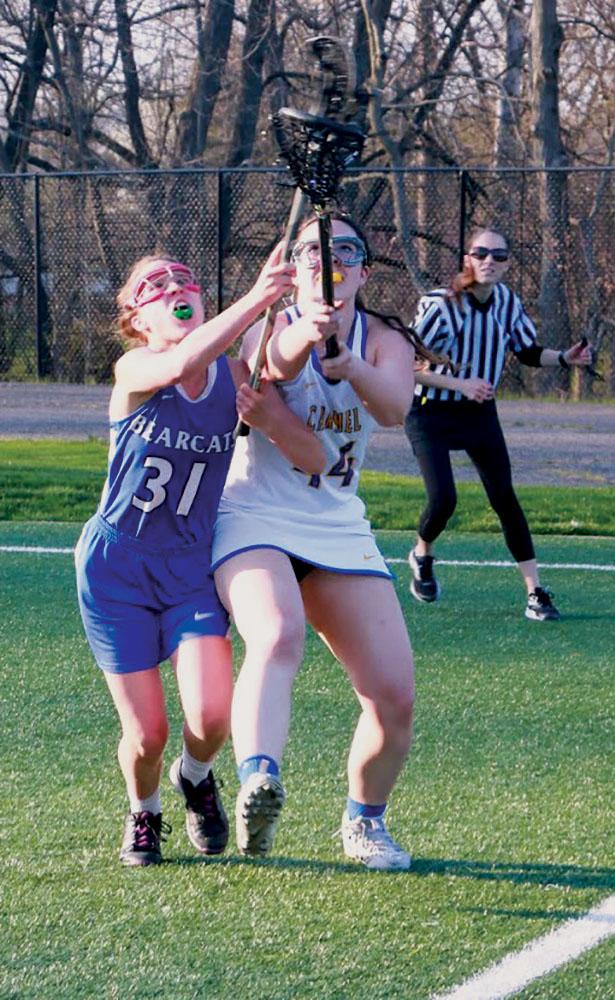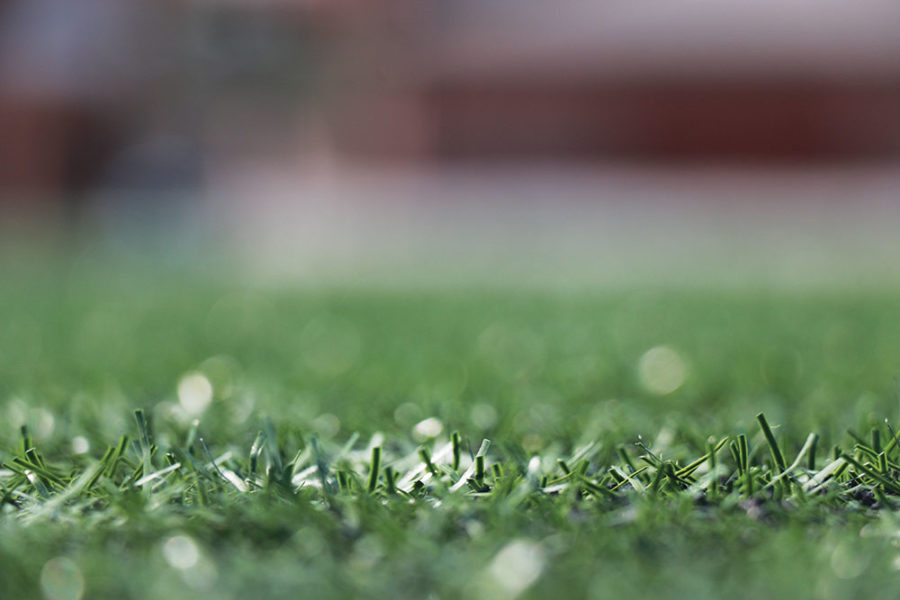 An often overlooked aspect of sports is the type of field or court upon which they are played. However, when field conditions are bad, people do notice. In 2016, the NFL Hall of Fame preseason game at Tom Benson Stadium between the Indianapolis Colts and Green Bay Packers, was canceled due to the field conditions being poor. The field was described as “like cement” by some players and was deemed unplayable. Playing surfaces can definitely have an effect on both quality of game play and player safety. At CHS, both men’s and women’s lacrosse teams have experienced firsthand, how the playing surface can affect a game.
An often overlooked aspect of sports is the type of field or court upon which they are played. However, when field conditions are bad, people do notice. In 2016, the NFL Hall of Fame preseason game at Tom Benson Stadium between the Indianapolis Colts and Green Bay Packers, was canceled due to the field conditions being poor. The field was described as “like cement” by some players and was deemed unplayable. Playing surfaces can definitely have an effect on both quality of game play and player safety. At CHS, both men’s and women’s lacrosse teams have experienced firsthand, how the playing surface can affect a game.
Maddie Dumke, lacrosse player and junior, said there are a lot of differences among lacrosse fields in the schools in Indiana.
“One of the main differences is Carmel has nice enough facilities where we are able to have turf fields, but we have been to schools where we have to play on grass, which is a big difference because we don’t get to practice on it very often, and it changes the way the ball moves when it hits the ground,” Dumke said.

Jack Hettiger, women’s lacrosse head coach, said most of the Indianapolis-area schools have turf fields, but Brownsburg, Avon and Center Grove don’t. Besides the type of field, the size of the field is also a difference between fields around the area.
“(Brownsburg, Avon and Center Grove’s fields) are going to play smaller; they’re going to play more like the men’s size fields, whereas the rest of the schools like Cathedral, Carmel, North Central and Fishers are all playing on the larger-size fields,” he said.
A difference Dumke described is the way the ball moves on turf versus on grass. The long blades of grass of a grass field cause the ball to bounce and roll less, while the harder turf causes the ball to bounce, roll and redirect more often.
“Turf is a lot bouncier, for one, so if someone misses a pass or the ball hits the ground, it’s (going to) bounce a lot differently on turf than if it’s in grass,” she said. “If it’s in grass, (the ball) sort of just stops where it is, so there is a lot more running involved because you’re not just waiting for the ball to get out of bounds. You have to get to it.”
Jacob Mahon, lacrosse player and sophomore, said he has noticed the same differences in the way that the ball bounces on turf versus grass.
“If someone doesn’t catch a pass (on turf), it can bounce more and you can lose the possession, or it can go out of bounds,” Mahon said.

Victoria Simmons, lacrosse player and junior, fights for control of the ball. Athletes are able to better pick up the ball on turf fields.
Although it may seem harmless, differences in fields can have a larger effect on the game than what some may think. Hettiger said he considers playing on grass more difficult than playing on turf.
“(Playing is) always a challenge on grass compared to turf because the ball rolls differently, and it’s going to play differently,” Hettiger said.
That difference has even affected games Hettiger’s team has played in the recent past. Dumke said she has experienced these differences and how much more difficult it made to play the game.
“When we used to play at Culver, the grass was really bumpy and really thick, so the ball just sort of sits wherever it gets dropped, so (the game is) definitely harder,” Dumke said.
The size, shape and type of field is not regulated by the IHSAA, which does not provide guidelines on field size and type. Most of the lacrosse teams in Indiana and the United States follow the guidelines set in place by U.S. Lacrosse, the national governing body for lacrosse in the United States. The guidelines state that a unified youth and high school field should be 120 yards in length, for both (women’s and men’s) lacrosse. Hettiger said his team, like others in the area, follow these guidelines.
“We use the U.S. Lacrosse regulation, so U.S. Lacrosse is kind of the governing body of lacrosse around the United States, so we use the fields in the requirements that U.S. Lacrosse has set forth and a few other schools do as well,” Hettiger said.
The lack of IHSAA regulation can cause differences among the playing surfaces in lacrosse.
Hettiger said, “From a play standpoint, it’s always (going to) be about the players first, obviously, but I think a field—turf or grass—can have an impact on the game. We’ve had some poor conditions where the field was definitely a factor.”
































![What happened to theater etiquette? [opinion]](https://hilite.org/wp-content/uploads/2025/04/Entertainment-Perspective-Cover-1200x471.jpg)














































![Review: “The Immortal Soul Salvage Yard:” A criminally underrated poetry collection [MUSE]](https://hilite.org/wp-content/uploads/2025/03/71cju6TvqmL._AC_UF10001000_QL80_.jpg)
![Review: "Dog Man" is Unapologetically Chaotic [MUSE]](https://hilite.org/wp-content/uploads/2025/03/dogman-1200x700.jpg)
![Review: "Ne Zha 2": The WeChat family reunion I didn’t know I needed [MUSE]](https://hilite.org/wp-content/uploads/2025/03/unnamed-4.png)
![Review in Print: Maripaz Villar brings a delightfully unique style to the world of WEBTOON [MUSE]](https://hilite.org/wp-content/uploads/2023/12/maripazcover-1200x960.jpg)
![Review: “The Sword of Kaigen” is a masterpiece [MUSE]](https://hilite.org/wp-content/uploads/2023/11/Screenshot-2023-11-26-201051.png)
![Review: Gateron Oil Kings, great linear switches, okay price [MUSE]](https://hilite.org/wp-content/uploads/2023/11/Screenshot-2023-11-26-200553.png)
![Review: “A Haunting in Venice” is a significant improvement from other Agatha Christie adaptations [MUSE]](https://hilite.org/wp-content/uploads/2023/11/e7ee2938a6d422669771bce6d8088521.jpg)
![Review: A Thanksgiving story from elementary school, still just as interesting [MUSE]](https://hilite.org/wp-content/uploads/2023/11/Screenshot-2023-11-26-195514-987x1200.png)
![Review: "When I Fly Towards You", cute, uplifting youth drama [MUSE]](https://hilite.org/wp-content/uploads/2023/09/When-I-Fly-Towards-You-Chinese-drama.png)
![Postcards from Muse: Hawaii Travel Diary [MUSE]](https://hilite.org/wp-content/uploads/2023/09/My-project-1-1200x1200.jpg)
![Review: "Ladybug & Cat Noir: The Movie," departure from original show [MUSE]](https://hilite.org/wp-content/uploads/2023/09/Ladybug__Cat_Noir_-_The_Movie_poster.jpg)
![Review in Print: "Hidden Love" is the cute, uplifting drama everyone needs [MUSE]](https://hilite.org/wp-content/uploads/2023/09/hiddenlovecover-e1693597208225-1030x1200.png)
![Review in Print: "Heartstopper" is the heartwarming queer romance we all need [MUSE]](https://hilite.org/wp-content/uploads/2023/08/museheartstoppercover-1200x654.png)



